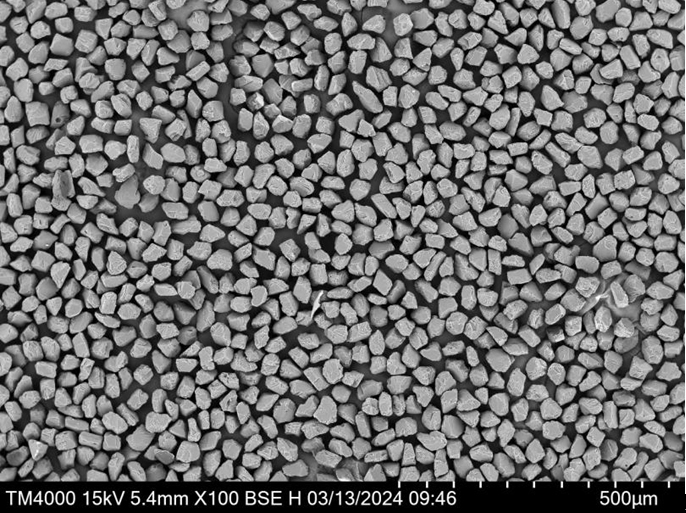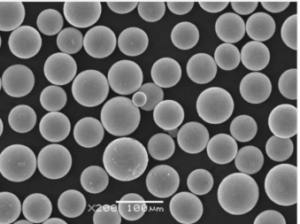Visão geral de Pó de CuSnZn
O pó de CuSnZn, também conhecido como pó de cobre-estanho-zinco, é um pó de liga especializado que oferece uma combinação única de propriedades mecânicas, resistência à corrosão e versatilidade em várias aplicações industriais. Esta liga normalmente compreende uma mistura equilibrada de cobre (Cu), estanho (Sn) e zinco (Zn), que trabalham sinergicamente para melhorar as propriedades do pó para uso em metalurgia, revestimentos, sinterização e brasagem.
A liga CuSnZn se destaca na categoria de pós metálicos devido ao seu equilíbrio de resistência e resistência à corrosão, tornando-a popular em indústrias que vão desde a automotiva e aeroespacial até a eletrônica e construção. Com a adição de estanho, a liga ganha maior resistência e tenacidade, enquanto o zinco introduz melhor resistência ao desgaste e qualidades anticorrosivas.
Vamos mergulhar mais fundo nos tipos, composição, características e aplicações do pó de CuSnZn. Também examinaremos modelos específicos, especificações e comparações para ajudá-lo a entender onde este pó de liga pode se encaixar em seus projetos.

Composição e Propriedades do Pó de CuSnZn
A composição do pó de CuSnZn varia ligeiramente dependendo das características desejadas, mas os componentes principais permanecem cobre, estanho e zinco em proporções variadas. Cada metal contribui com propriedades únicas para a liga:
| Componente | Símbolo | Faixa de composição típica (%) | Propriedades contribuídas |
|---|---|---|---|
| Cobre | Cu | 60-90% | Alta condutividade térmica/elétrica, ductilidade |
| Estanho | Sn | 5-20% | Resistência, dureza, resistência à corrosão |
| Zinco | Zn | 5-20% | Resistência ao desgaste, maior resistência, menor ponto de fusão |
Compreendendo o papel de cada componente
- Cobre (Cu): O metal primário, o cobre, fornece ductilidade essencial, tornando o pó fácil de moldar e formar. Sua alta condutividade elétrica também o torna favorável para aplicações eletrônicas.
- Estanho (Sn): A adição de estanho fortalece a liga, melhora a dureza e aumenta a resistência à corrosão, tornando-a ideal para peças mecânicas.
- Zinco (Zn): O zinco adiciona resistência ao desgaste e contribui para a diminuição do ponto de fusão, o que é vantajoso em aplicações como brasagem e soldagem.
Características do pó de CuSnZn
A mistura única de pó de CuSnZn leva às seguintes características notáveis:
| Característica | Detalhes |
|---|---|
| Resistência à corrosão | Alta resistência à corrosão em vários ambientes devido ao teor de cobre e estanho. |
| Força | A liga é resistente e durável, tornando-a ideal para aplicações estruturais e mecânicas. |
| Resistência ao desgaste | O zinco melhora a resistência ao desgaste, adequado para componentes de alta tensão. |
| Condutividade térmica | Alta condutividade térmica graças ao cobre, útil em aplicações sensíveis ao calor. |
| Baixo ponto de fusão | Menor ponto de fusão do que o cobre puro, permitindo melhor brasagem e sinterização. |
Tipos e Graus de Pó de CuSnZn
Aqui estão alguns dos tipos mais comuns e modelos específicos de pó de CuSnZn, cada um otimizado para necessidades industriais específicas. Esses pós variam em termos de tamanho de partícula, composição e aplicação.
| Nome do modelo | Composição (Cu-Sn-Zn %) | Aplicativo | Propriedades exclusivas |
|---|---|---|---|
| CuSn10Zn2 | 88-10-2 | Revestimentos decorativos, joias | Excelente resistência à corrosão |
| CuSn5Zn5 | 90-5-5 | Contatos elétricos, revestimentos de baixo atrito | Alta condutividade elétrica |
| CuSn8Zn4 | 88-8-4 | Rolamentos, buchas | Resistência ao desgaste aprimorada |
| CuSn6Zn3 | 91-6-3 | Engrenagens, peças de máquinas pequenas | Resistência e usinabilidade equilibradas |
| CuSn9Zn1 | 90-9-1 | Brasagem e soldagem | Ponto de fusão mais baixo |
| CuSn7Zn2 | 91-7-2 | Componentes aeroespaciais, trocadores de calor | Alta condutividade térmica |
| CuSn12Zn1 | 87-12-1 | Componentes automotivos, fixadores | Resistência aprimorada |
| CuSn3Zn5 | 92-3-5 | Conexões industriais, sedes de válvulas | Boa resistência ao desgaste abrasivo |
| CuSn11Zn4 | 85-11-4 | Equipamentos marítimos, hélices | Resistência superior à corrosão na água |
| CuSn15Zn2 | 83-15-2 | Peças mecânicas de alta tensão | Alta dureza e resistência à tração |
Cada um desses modelos oferece forças ligeiramente diferentes, tornando crucial a escolha do tipo certo para necessidades específicas.









Aplicações do pó de CuSnZn
A versatilidade do pó de CuSnZn o torna adequado para uma ampla gama de aplicações:
| Aplicativo | Detalhes |
|---|---|
| Setor automotivo | Rolamentos, buchas, engrenagens, devido à resistência ao desgaste e durabilidade. |
| Indústria aeroespacial | Componentes em motores e peças estruturais que exigem alta resistência e resistência à corrosão. |
| Eletrônicos | Contatos elétricos, conectores e materiais de dissipação de calor. |
| Engenharia marítima | Hélices, acessórios marítimos, devido à resistência superior à corrosão. |
| Fabricação Industrial | Rolamentos, buchas, revestimentos de baixo atrito para máquinas. |
| Joias e Artes Decorativas | Usado para revestimentos estéticos, joias devido à cor atraente e durabilidade. |
| Brasagem e soldagem | Ligas de baixo ponto de fusão que fornecem forte ligação em juntas metálicas. |
| Trocadores de calor | Alta condutividade térmica é benéfica para transferência de calor eficiente. |
Especificações dos modelos de pó de CuSnZn
| Modelo | Faixa de tamanho de partícula (µm) | Densidade (g/cm³) | Ponto de fusão (°C) | Dureza (HV) |
|---|---|---|---|---|
| CuSn10Zn2 | 20-45 | 7.6 | 980 | 120 |
| CuSn5Zn5 | 15-50 | 7.7 | 990 | 110 |
| CuSn8Zn4 | 25-60 | 7.5 | 970 | 130 |
| CuSn6Zn3 | 10-40 | 7.65 | 980 | 125 |
| CuSn9Zn1 | 5-30 | 7.8 | 950 | 115 |
| CuSn7Zn2 | 20-60 | 7.7 | 960 | 130 |
| CuSn12Zn1 | 15-45 | 7.6 | 940 | 140 |
| CuSn3Zn5 | 20-55 | 7.75 | 930 | 110 |
| CuSn11Zn4 | 25-70 | 7.6 | 920 | 135 |
| CuSn15Zn2 | 10-50 | 7.5 | 910 | 145 |
Vantagens e limitações do Pó de CuSnZn
| Recurso | Vantagens | Limitações |
|---|---|---|
| Resistência à corrosão | Altamente resistente à corrosão em ambientes marinhos e industriais. | Menos resistente do que algumas outras ligas em condições ácidas extremas. |
| Resistência ao desgaste | Excelente resistência ao desgaste, especialmente com adição de zinco. | O maior teor de zinco pode levar à fragilidade em algumas aplicações. |
| Condutividade térmica | Eficiente na transferência de calor, útil para eletrônicos e trocadores de calor. | Não tão alto quanto o cobre puro ou ligas de cobre-alumínio em aplicações térmicas. |
| Resistência e dureza | Fornece um bom equilíbrio de resistência e dureza, ideal para peças que suportam carga. | Pode ser mais macio do que ligas à base de aço, limitando o uso em aplicações de estresse extremamente alto. |
| Usinabilidade | Facilmente usinável com ferramentas padrão, reduzindo os custos de produção. | O maior teor de estanho ou zinco pode reduzir a usinabilidade devido ao aumento da fragilidade. |
| Custo | Geralmente mais acessível do que o cobre puro ou ligas especializadas. | Os preços flutuam com a demanda do mercado por cobre, estanho e zinco. |
Principais fornecedores e informações de preços
| Fornecedor | País | Preço médio (por kg) | Notas disponíveis |
|---|---|---|---|
| ABC Metals | EUA | $25 – $40 | CuSn10Zn2, CuSn5Zn5 |
| Global Alloy Ltd. | Alemanha | $28 – $45 | CuSn8Zn4, CuSn6Zn3 |
| Alloy World | Japão | $30 – $42 | CuSn7Zn2, CuSn12Zn1 |
| Metals R Us | REINO UNIDO | $27 – $38 | CuSn3Zn5, CuSn11Zn4 |
| CobreCraft | China | $20 – $35 | CuSn9Zn1, CuSn15Zn2 |

Perguntas frequentes
| Pergunta | Resposta |
|---|---|
| Para que serve o pó de CuSnZn? | É amplamente utilizado nas indústrias automotiva, aeroespacial, marítima e eletrônica devido à sua resistência à corrosão. |
| O pó de CuSnZn pode substituir o cobre puro? | Em muitos casos, sim. Ele oferece condutividade térmica semelhante, mas com maior resistência e resistência à corrosão. |
| Qual é a faixa de preço típica? | Os preços variam entre US$ 20 e US$ 45 por kg, dependendo da composição e do fornecedor. |
| O pó de CuSnZn é bom para brasagem? | Absolutamente, o baixo ponto de fusão o torna uma excelente escolha para aplicações de brasagem e soldagem. |
| Qual é a principal vantagem desta liga? | A liga oferece uma combinação equilibrada de resistência, resistência ao desgaste e resistência à corrosão. |

